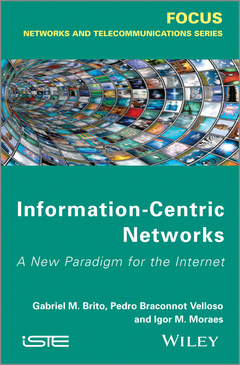Description
Information-Centric Networks
A New Paradigm for the Internet
Authors: de Brito Gabriel M., Velloso Pedro B., Moraes Igor M.
Language: English
Subject for Information-Centric Networks:
171.59 €
In Print (Delivery period: 14 days).
Add to cart138 p. · 16x24.1 cm · Hardback
Description
/li>Contents
/li>Biography
/li>
Since its inception, the Internet has evolved from a textual information system towards a multimedia information system, in which data, services and applications are consumed as content. Today, however, the main problem faced is that applications are now content-oriented but the protocol stack remains the same, based on the content location. Thus, it is clear that the Internet?s current architecture must change. This new architecture should take into account aspects to improve content location and delivery efficiency and also content availability. Fulfilling these requirements is the main goal of information-centric networks (ICNs).
ICN is a new communication paradigm to increase the efficiency of content delivery and also content availability. In this new concept, the network infrastructure actively contributes to content caching and distribution. This book presents the basic concepts of ICNs, describes the main architecture proposals for these networks, and discusses the main challenges to their development. Information Centric-Networks looks at the current challenges for this concept, including: naming, routing and caching on the network-core elements, several aspects of content security, user privacy, and practical issues in implementing ICNs.
Contents
1. Content Distribution on the Internet.
2. Information-Centric Networks.
3. Main ICN Architectures.
4. Challenges.
5. Practical Issues.
About the Authors
Gabriel M. Brito is an Engineer at Petrobras in Brazil and studying for a Master?s degree at the Universidade Federal Fluminense in Brazil.
Pedro Braconnot Velloso is an Associate Professor in the Department of Computer Science at the Universidade Federal Fluminense (UFF), Brazil. He worked for Bell Labs France as a research engineer from 2009 to 2011.
Igor M. Moraes is an Associate Professor at the Universidade Federal Fluminense in Brazil.
INTRODUCTION ix
CHAPTER 1. CONTENT DISTRIBUTION ON THE INTERNET 1
1.1. End-to-end concept and limitations 2
1.2. Multicast communication 4
1.3. Peer-to-peer systems 5
1.4. Content distribution networks 6
1.5. Publish/subscribe systems 9
CHAPTER 2. INFORMATION-CENTRIC NETWORKS 13
2.1. Content naming 13
2.1.1. Flat naming 14
2.1.2. Hierarchical naming 16
2.1.3. Attribute-based names 17
2.2. Content or name-based routing 18
2.2.1. Non-hierarchical routing 19
2.2.2. Hierarchical routing 20
2.3. Content caching 22
CHAPTER 3. MAIN ICN ARCHITECTURES 23
3.1. Content-based networking/combined broadcast and content-based 23
3.2. Data-oriented network architecture 26
3.3. Content-centric networking/named-data networking 29
3.4. Publish-subscribe Internet routing paradigm/publish-subscribe Internet technologies 33
3.5. Content-centric inter-network architecture 37
3.6. Other architectures 40
3.7. General comparison 41
CHAPTER 4. CHALLENGES 43
4.1. Naming 43
4.2. Routing 52
4.3. Caching 58
4.3.1. Analytical models for networks of caches 60
4.3.2. Content replacement policies 62
4.3.3. Content storage policies 65
4.4. Security 69
4.5. Mobility support in ICN 73
4.6. Applications 78
4.6.1. Real-time applications 78
4.6.2. Vehicular networks 80
4.6.3. Autonomous driving 81
4.6.4. Other applications 82
CHAPTER 5. PRACTICAL ISSUES 83
5.1. Economic models 83
5.2. Content routers 88
CONCLUSION 97
ACKNOWLEDGMENT 99
BIBLIOGRAPHY 101
INDEX 119
Gabriel M. Brito is an Engineer at Petrobras in Brazil and studying for a Master's degree at the Universidade Federal Fluminense in Brazil.
Pedro Braconnot Velloso is an Associate Professor in the Department of Computer Science at the Universidade Federal Fluminense (UFF), Brazil. He worked for Bell Labs France as a research engineer from 2009 to 2011.
Igor M. Moraes is an Associate Professor at the Universidade Federal Fluminense in Brazil.




